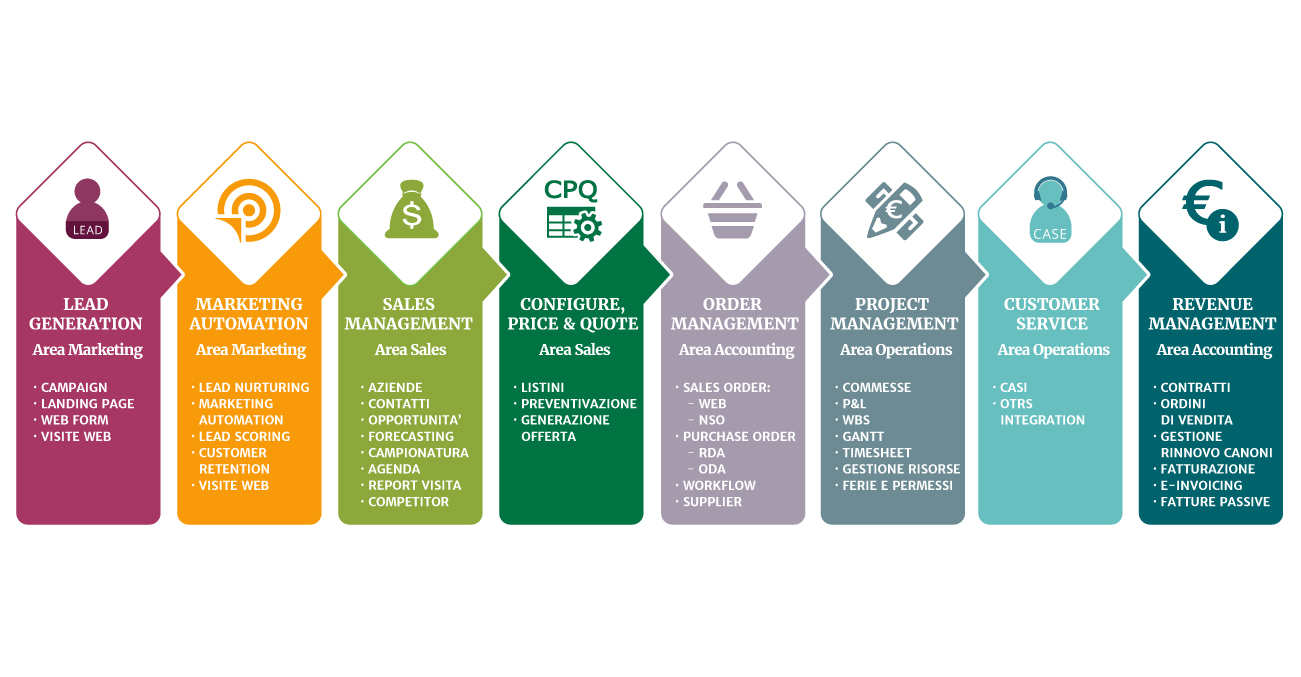Mastering the Lead to Cash process means finding solutions capable of triggering that virtuous circle of company performance.From lead generation to invoice payment all in one integrated tool.
1. Lead to Opportunity
From the Lead generation to the creation of an Opportunity
Identification and evaluation of potential customers (Leads) through appropriate lead generation tools. The leads generated and positively evaluated are assigned to a salesperson who will be in charge of converting them into contacts and taking care of the relationship up to the creation of an economic opportunity for the management of the sales negotiation.
2. Opportunity to Quote
From the Opportunity to the formulation of an Offer
The opportunity is accompanied by one or more economic estimates using technologically advanced tools such as CPQ.Based on the chosen estimate, it is possible to formulate automatically an offer to be sent to the customer.
3. Quote to Order
From the Economic Offer to the receipt of the Sales Order
The offer sent to the customer is negotiated until a final agreement is reached. Once the sales order is received, the opportunity is converted into a contract.
4. Order to Cash
From the Sales Order to the Invoice collection
From the sales order, the sale of the good/service or the opening of an order follows. With their delivery, invoices are issued, monitoring that payments are made in compliance with deadlines.
ZenShare Suite is based on Lead to Cash
The ZenShare Suite offers the end customer a complete application tool capable of managing business processes (primary and support) without interruption:
- marketing (primary process)
- sales (primary process)
- customer care (primary process)
- administration (support process)
- production by job order (primary process)
- purchases (support process)
- human resources (process support)
- e-invoicing (support process)


Acquisisci lead attraverso molteplici punti di contatto.
Assegna il lead con punteggio alto al commerciale di competenza.
Qualifica e valuta le leads dando priorità a quelli più interessanti.
Dopo il feed-back positivo del commerciale converti la lead in contatto.
Accresci la conoscenza che i leads hanno della tua azienda.
Identifica le opportunità a più alto potenziale.
Configura i preventivi
in modo strutturato.
Definisci le caratteristiche dell’opportunità.
Invia il preventivo
al cliente.
Gestisci i campioni
di prodotto.
Presidia le informazioni
sull’opportunità.
Gestisci la negoziazione
del preventivo.
Approva l’ordine
di vendita.
Monitora lo stato
della quotazione.
Converti l’opportunità
in contratto.
Valida l’ordine
di vendita.
Invia l’ordine di vendita
al gestionale.
Pianifica le attività, alloca le risorse, gestisci gli ordini.
Gestisci i servizi di assistenza al cliente: customer care e case management
Monitora ricavi, costi, spese, margini di redditività e scostamenti economici.
Emetti fattura e controlla l’incasso.
Chiudi la commessa
a progetto ultimato
Chiudi il contratto. Stanno maturando nuove opportunità di vendita? Reinnesca il processo!